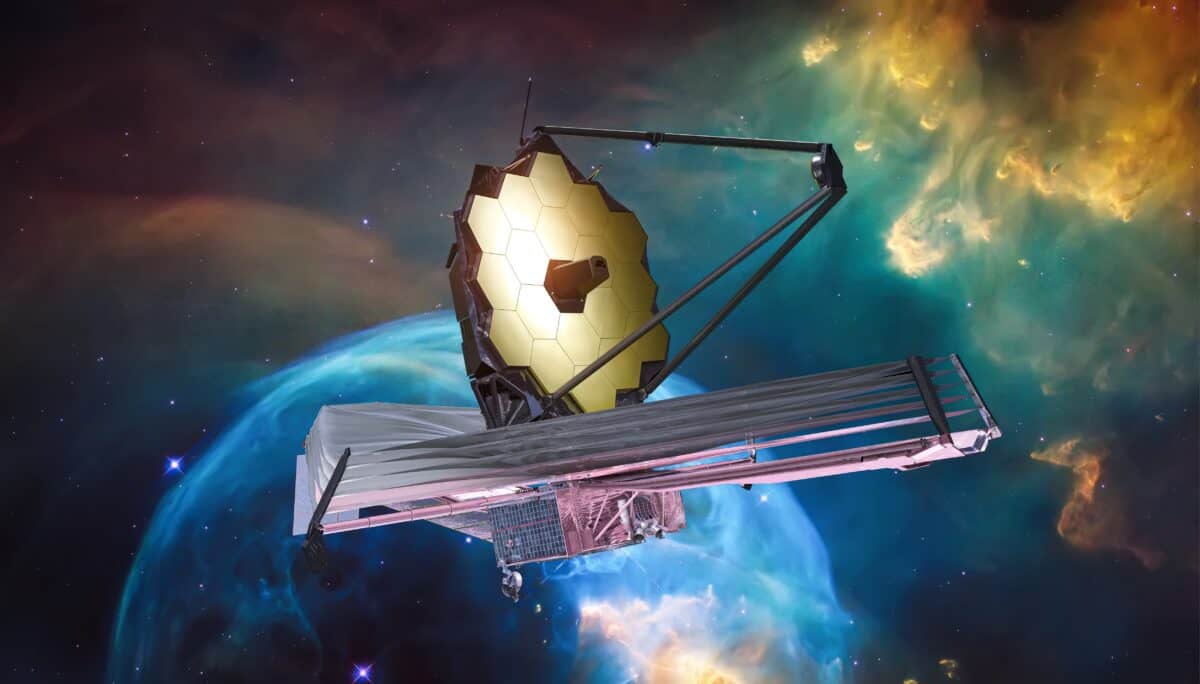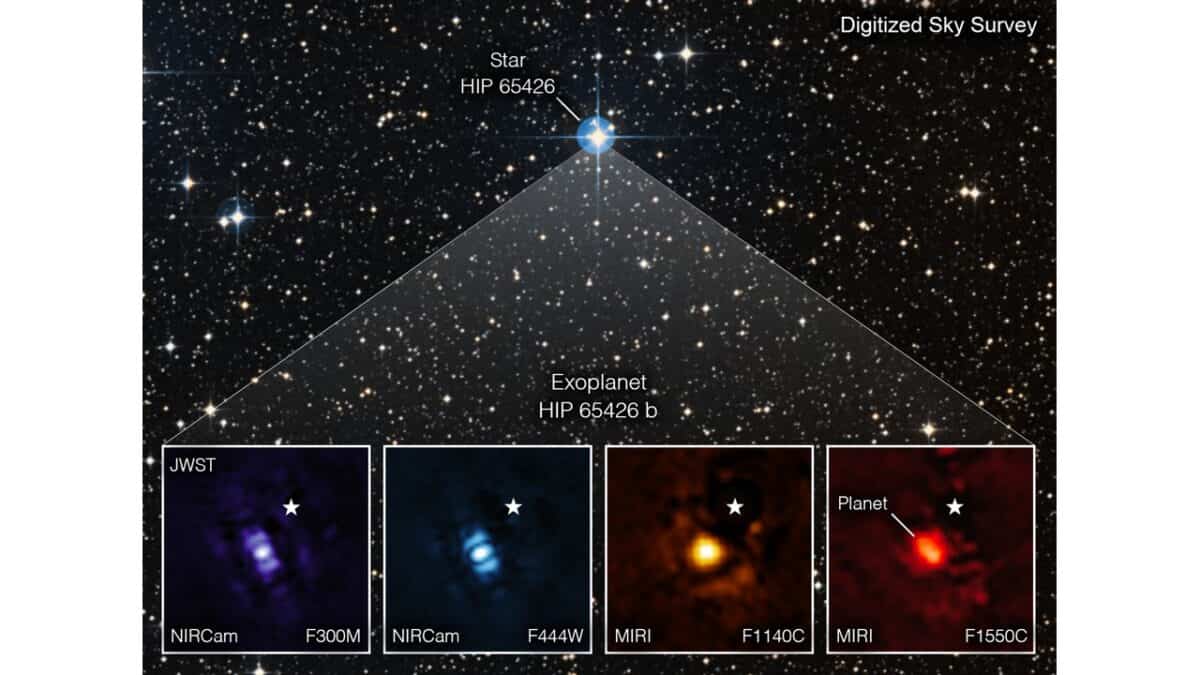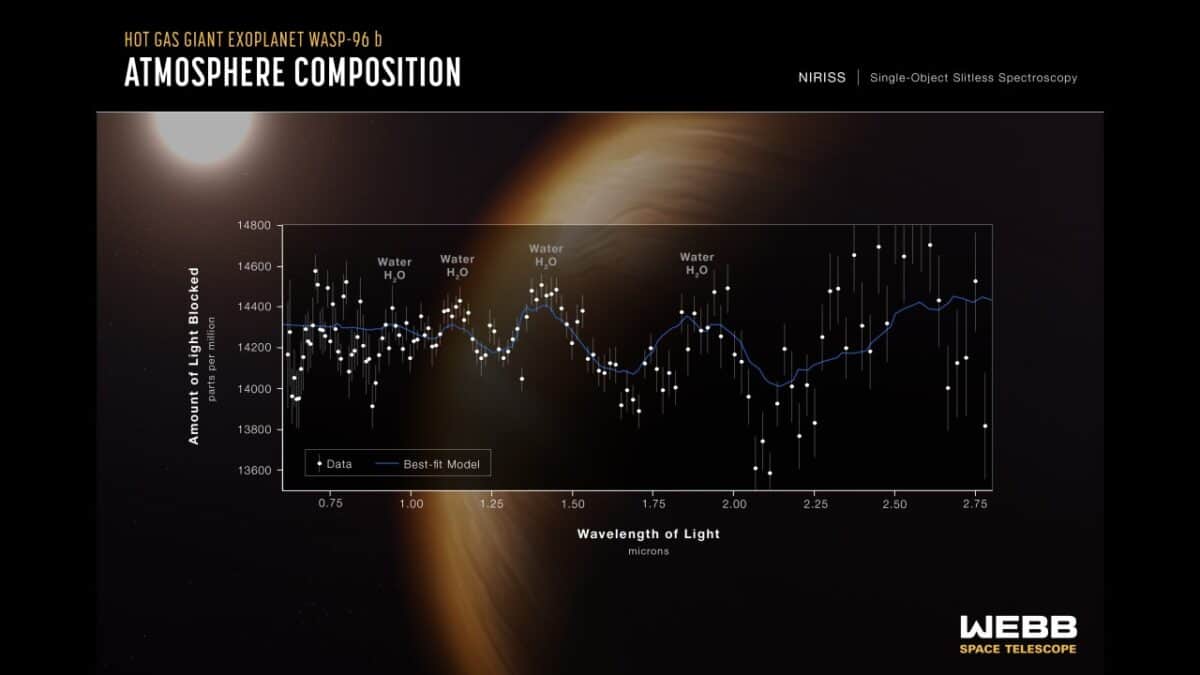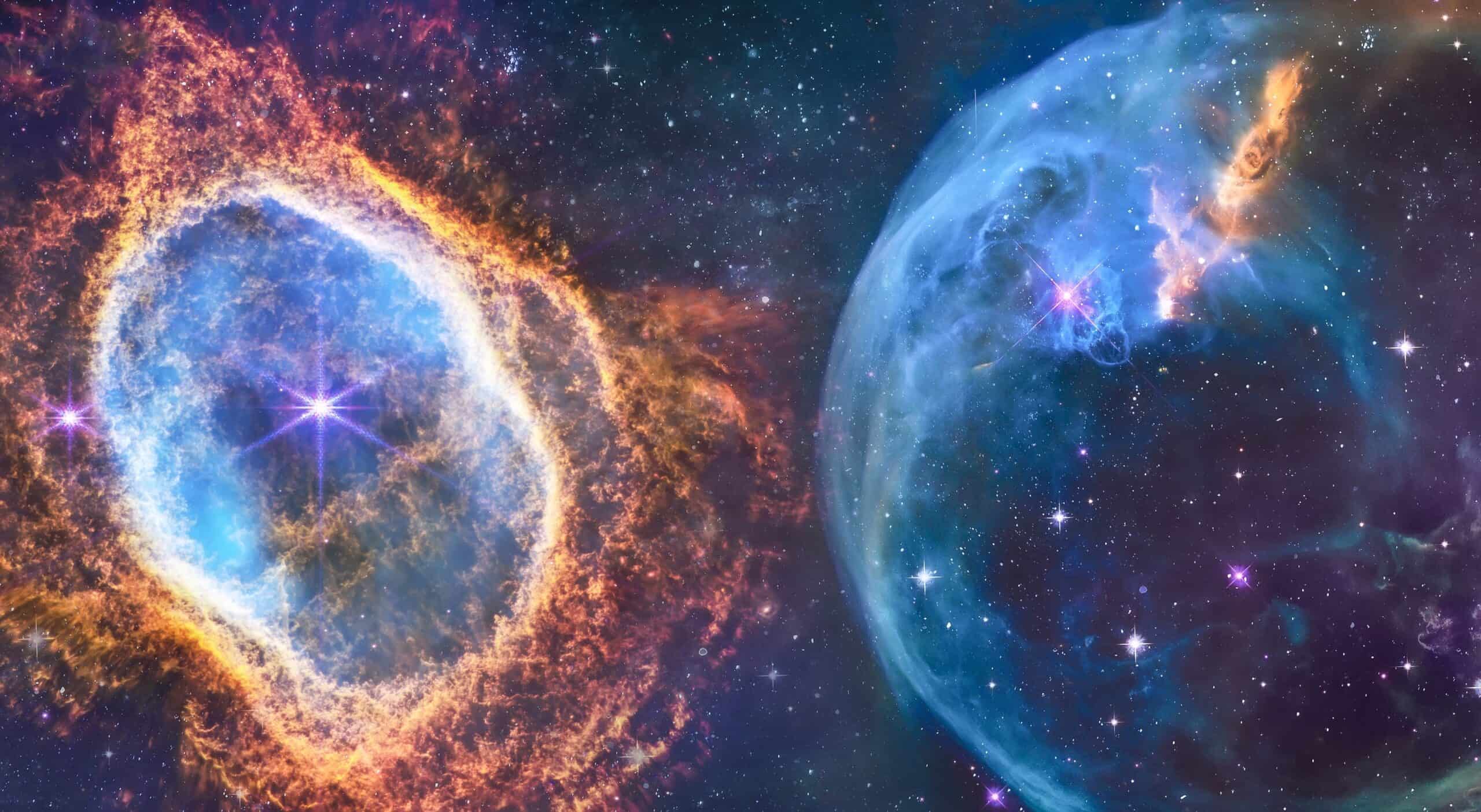During its short tenure in space, the James Webb Telescope is rewriting and augmenting much of what we know about our universe. Let’s jump in and look at the James Webb telescope discoveries, from exoplanets to asteroid belts.
What’s Special About the James Webb Telescope?
To appreciate James Webb Telescope discoveries, we need to take a quick look at what makes the telescope so unique.
It’s Gigantic
The James Webb Telescope (JWST) is the largest telescope ever placed in space, with 270 ft2 of primary combined collection mirror surface area. The Hubble Space Telescope has 50 ft2 of primary combined collection mirror surface area.
So! Many! Mirrors!
- The JWST has 18 beryllium hexagon-shaped mirrors coated with gold. Each hexagon-shaped section of the primary mirror has seven actuators. The actuators allow the position of each mirror to be adjusted independently of the other mirrors.
- The ability to adjust each mirror independently and correct positioning errors ultimately allows all 18 mirrors to act as a single mirror.
Crazy Good Light Collection Optics

Bigger is better! The primary mirror’s large (270 ft2) surface collection area can collect smaller, fainter signals that the Hubble Space Telescope couldn’t capture.
The JWST light collection optics are so good that we can peer back about 13.4 billion years ago. We can “see” what happened as the universe developed approximately 300 million years after the big bang. We can see the light emanate from the formation of the first galaxies.
Hubble Collection Optics
The Hubble Space Telescope is primarily designed to capture electromagnetic data from optical and ultraviolet wavelengths.
JWST Collection Optics
Infrared detection is the primary purpose of the JWST. As light travels long distances, the wavelength shifts. Electromagnetic waves that began as visible to the human eye (and Hubble) shifted to longer (or shorter) wavelengths that are not captured by the human eye (or Hubble). The JSWT can “see” approximately 150 billion years earlier (in time) than the Hubble Space Telescope.
The JWST Is Just Getting Started!
As crazy as it sounds, the JWST has only been in service for about a year. The JWST launched on December 25, 2021, and entered into service in late June 2022. In that short time, the JWST reveals a fantastic amount of data.
Let’s jump in and look at the 5 Things James Webb has discovered, from exoplanets to asteroid belts.
James Webb Telescope Discovery #1: Early Galaxy Formation
The ability to see back in time quickly upended much of what scientists believe about the formation of galaxies. The JWST used its UV detection capabilities to discover six (optically redshifted) gigantic galaxies that existed about 500 million to 700 million years after the Big Bang.
These objects are way more massive than anyone expected,” said study coauthor Joel Leja, assistant professor of astronomy and astrophysics at Penn State University, in a statement. “We expected only to find tiny, young, baby galaxies at this point in time, but we’ve discovered galaxies as mature as our own in what was previously understood to be the dawn of the universe.
Joel Leja/ CNN
Detecting mature galaxies instead of young galaxies calls into question almost everything scientists believed about galaxy formation. There are two leading theories on the formation of galaxies.
Galaxy Formation Theory #1 (Most Accepted Theory)
Stars form when dust and gas collapse due to their own gravitational pull.
Galaxy Formation Theory #2 (Not So Popular)
Small matter clumps together. More small matter sticks onto the small clustered matter. Repeat the process until the galaxy formation is complete.
What Does It Mean?
The accepted theory of galaxy formation is called into question by the discovery of mature galaxies at the early stages of the universe following the Big Bang. If the most accepted theory is correct, how can mature galaxies exist? Shouldn’t they still be developing?
The detection of these six gigantic galaxies means that 99% of the computer modeling algorithms for how the universe developed need to be corrected. WHOA! Better dust off the “Delete” key!
James Webb Telescope Discovery #2: Exoplanets
Optical images and some infrared analysis were the primary detection methods of exoplanets (planets in another solar system) until the JWST blasted into space with IR capabilities.
When an exoplanet passes in front of “its” star, the intensity of the star decreases in the area in front of the exoplanet. We couldn’t “see” the planet, but we could “see” the effects of an exoplanet orbiting its own sun.
The JWST is peeling back the shroud of mystery surrounding exoplanets and allowing us to understand planet formation.
HIP 65426
The gas giant exoplanet HIP 65426-b orbits the star called HIP 65426. HIP 65426-b is about 385 light years away from Earth.

Where’s the Exoplanet?
The exoplanet’s spectra signature is buried inside the (very bright) spectral signature from the star itself. JWST collecting data from this star isn’t groundbreaking; the Hubble space telescope has already collected data.
Collecting More Wavelengths Than the Hubble Space Telescope
What is different from the Hubble Space Telescope is JWST’s ability to collect from a more comprehensive wavelength range, block unwanted signals, and filter the data. The JWST utilizes a Near Infrared Camera (NIRCam) and a MIRI Mid-Infrared Instrument (MIRI.)
- The NIRCam is an infrared camera designed for wavelengths between .6 to 5 microns.
- The MIRI is a mid-range infrared spectrograph that defects wavelengths between 5 and 28 microns.
NIRCam and MIRI
The Near Infrared Camera (NIRCam) is the James Webb Telescopes’ primary imager. The NIRCam covers the infrared wavelength range of 0.6 to 5 microns.
- The purple image shows the Near Infrared Camer (NICCam) with a wavelength of 3 microns.
- The blue image shows the Near Infrared Camer (NICCam) with a wavelength of 4.44 microns.
- The yellow image shows the MIRI Mid-Infrared Instrument (MIR)) with a wavelength of 11.4 microns.
- The red image shows the MIRI Mid-Infrared Instrument (MIRI) with a wavelength of 15.5 microns.
Coronagraph
A coronagraph, in addition to NIRCam and MIRI, modifies the incoming signal. A coronagraph is a mirror with several lenses that focus the incoming light signal. Adjusting the mirrors and lenses blocks roughly 98.55 of a star’s light.
WASP-96b
WASP-96b is a gas giant exoplanet located about 1,120 light years from Earth. Earthside astronomers proved in 2018 that WASP-96 has bright and clear skies.
Clouds, dust, and gasses are the bane of planetary scientists with high hopes to see exoplanets. The JWST was able to analyze the atmospheric composition of WASP-96b with its Near Infrared Imager and Slitless Specograph (NIRISS).

JWST’s spectrograph data reveals that WASP-96b has clouds, water vapor, and hazes. The new Webb measurements show evidence of water vapor, hazes, and previously unseen clouds.
Measurements like this allow planetary scientists to understand planet formation. Knowledge learned from WASP-96b increases the understanding of the formation of other exoplanets.
Proof of Concept
The excitement about the exoplanets and the JWST data is about more than just the exoplanets themselves. (Sorry, exoplanets!) The high level of excitement is really about what kind of data JWST can provide. The data preview the type of information scientists can cull from upcoming observations.
James Webb Telescope Discovery #3: What’s That Asteroid?
Detected (by chance!) inside the telescope’s Mid-InfraRred calibration data set was data from a random asteroid! It’s the smallest object detected by the JWST, measuring just under 0.6 miles long. The asteroid is about the size of the Roman Colosseum.
Scientists are enthusiastic about the asteroid discovery because it highlights JWST detection capability for small objects. Astronomy primarily focuses on larger objects simply because we can see or detect them and plot their course across the skies.
More minor asteroids may have just as much scientific information to provide as larger asteroids. Both sets of asteroids originated from the birth of the solar system (our home!) about 4.5 billion years ago. Studying asteroids close to Earth may explain the formation of Earth.
James Webb Telescope Discovery #4: Pillars of Creation
Hubble Space Telescopes images of the Pillars of Creation are iconic. The image on the left awakened the imaginations of a new generation of astronomers twenty years ago.

The JWST is doing well on the image front too! It’s hard to overstate how inspirational these images are for budding STEM students. Twenty years from now, we may look back at the JWST Pillars of Creation in amazement, both in how far we’ve come since 2023 and how much better the technology we have available in 2043 is!
The Pillars of Creation show the elephant trunks of interstellar gas and dust in the Eagle Nebula, about 6,500 light-years from Earth. Data from the NIRCam and MIRI and “stacked” onto each other to form a composite image.
We’re now able to “see through” some of the dust in the Hubble Space Telescopes Images. We’re now able to see newly formed stars, thousands of them. Dust is a crucial ingredient in star formation.
The thick bands of dust combined with gas form the “pillars.” As the pillars begin to collapse due to gravitational forces, they slowly heat up, and a new star is born.
James Webb Telescope Discovery #5: Wolf-Rayet 124
Wolf-Rayet stars are the brightest, most prominent, and rarest stars. These massive stars are at the end of their lives. A Wolf-Rayet star consumes itself quite rapidly and then explodes apart.
Some stars will live for billions of years. Other stars, the biggest stars, have shorter lifespans. Wolf-Rayet stars only live for a few million years and are in the final phase of their — one that will only last a few hundred thousand years.

WR 124 is about 15,000 light-years from Earth in the constellation Sagitta. The star is rapidly shrinking as hot gasses are blown off the star’s surface and into space.
Infrared radiation illuminates the star. The JWST’s NIRCam and MIRI collected data from this rare star. The images were “stacked” onto each other to form a composite image. When Wolf-Rayet 124 (or any other Wolf-Raynet star) finally explodes, it’s called a “Supernova Explosion.”
A supernova explosion occurs after the star has consumed all of the elements (hydrogen, followed by helium, followed by carbon, etc.) until it reaches iron. All heck breaks loose at the iron element!
The star can’t consume the iron and collapses in on itself. The entire collapse, start to finish, takes about a quarter of a second. A shockwave will travel through the core, exit the star, and create an incredible display.
The image featured at the top of this post is ©Dima Zel/Shutterstock.com.








